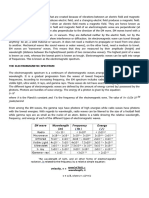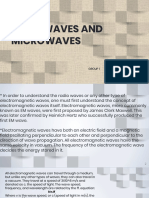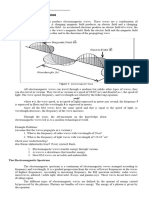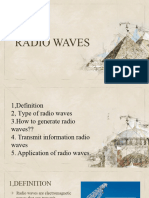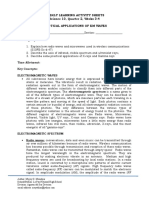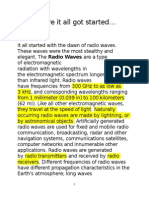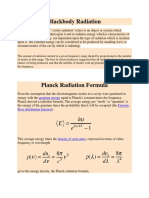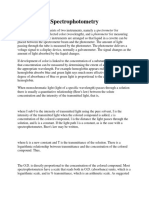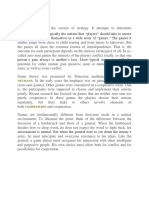0 ratings0% found this document useful (0 votes)
21 viewsElectromagnetic (EM) Spectrum University of Rochester Microwaves Infrared Ultraviolet X-Rays Gamma-Rays Nasa
Uploaded by
Vijay KumarCopyright
© © All Rights Reserved
Available Formats
Download as DOCX, PDF, TXT or read online on Scribd
0 ratings0% found this document useful (0 votes)
21 viewsElectromagnetic (EM) Spectrum University of Rochester Microwaves Infrared Ultraviolet X-Rays Gamma-Rays Nasa
Uploaded by
Vijay KumarCopyright
© © All Rights Reserved
Available Formats
Download as DOCX, PDF, TXT or read online on Scribd
You are on page 1/ 1
Radio waves are a type of electromagnetic radiation best-known for their use in
communication technologies, such as television, mobile phones and radios. These
devices receive radio waves and convert them to mechanical vibrations in the speaker
to create sound waves.
The radio-frequency spectrum is a relatively small part of the electromagnetic (EM)
spectrum. The EM spectrum is generally divided into seven regions in order of
decreasing wavelength and increasing energy and frequency, according to
the University of Rochester. The common designations are radio
waves, microwaves, infrared (IR), visible light, ultraviolet (UV), X-rays and gamma-rays.
Radio waves have the longest wavelengths in the EM spectrum, according to NASA,
ranging from about 0.04 inches (1 millimeter) to more than 62 miles (100 kilometers).
They also have the lowest frequencies, from about 3,000 cycles per second, or 3
kilohertz, up to about 300 billion hertz, or 300 gigahertz.
The radio spectrum is a limited resource and is often compared to farmland. Just as
farmers must organize their land to achieve the best harvest regarding quantity and
variety, the radio spectrum must be split among users in the most efficient way,
according to the British Broadcasting Corp. (BBC). In the U.S., the National
Telecommunications and Information Administration within the United States
Department of Commerce manages the frequency allocations along the radio spectrum.
You might also like
- Electromagnetic Radiation Frequency Wavelength Speed of Light Photon SpectrumNo ratings yetElectromagnetic Radiation Frequency Wavelength Speed of Light Photon Spectrum11 pages
- Wavelengths Electromagnetic Spectrum Infrared GHZ KHZ in Speed of Light Radar Communications SatellitesNo ratings yetWavelengths Electromagnetic Spectrum Infrared GHZ KHZ in Speed of Light Radar Communications Satellites1 page
- Radio Wave Radio Waves Are A Type of Electromagnetic Radiation With Wavelengths inNo ratings yetRadio Wave Radio Waves Are A Type of Electromagnetic Radiation With Wavelengths in8 pages
- Electromagnetic Waves Have Many Uses.: How Can You Make Radio Waves?No ratings yetElectromagnetic Waves Have Many Uses.: How Can You Make Radio Waves?8 pages
- Electromagnetic Spectrum HZ GHZ Radio Waves Telecommunication Transmission International Telecommunication UnionNo ratings yetElectromagnetic Spectrum HZ GHZ Radio Waves Telecommunication Transmission International Telecommunication Union1 page
- Introduction To Electromagnetic SpectrumNo ratings yetIntroduction To Electromagnetic Spectrum4 pages
- The Electromagnetic Spectrum For Review DocsNo ratings yetThe Electromagnetic Spectrum For Review Docs8 pages
- Grade 10 Quarter 2 Module 2 - Practical Applications of EM WavesNo ratings yetGrade 10 Quarter 2 Module 2 - Practical Applications of EM Waves15 pages
- Portfolio Project - The Practicality of The Electromagnetic SpectrumNo ratings yetPortfolio Project - The Practicality of The Electromagnetic Spectrum17 pages
- Weekly Learning Activity Sheets Science 10, Quarter 2, Weeks 3-4 Practical Applications of em Waves100% (2)Weekly Learning Activity Sheets Science 10, Quarter 2, Weeks 3-4 Practical Applications of em Waves13 pages
- Electromagnetic Waves Practical ApllicationsNo ratings yetElectromagnetic Waves Practical Apllications58 pages
- Blackbody Radiation: Quantum Energy Einstein-Bose Distribution FunctionNo ratings yetBlackbody Radiation: Quantum Energy Einstein-Bose Distribution Function1 page
- Carnot Cycle: Isothermal Processes Adiabatic Processes Second Law of ThermodynamicsNo ratings yetCarnot Cycle: Isothermal Processes Adiabatic Processes Second Law of Thermodynamics1 page
- Anemometers Heat A Wire To A Specified Temperature and Then Measure TheNo ratings yetAnemometers Heat A Wire To A Specified Temperature and Then Measure The1 page
- Specific Gravity Liquids: Density Water TemperatureNo ratings yetSpecific Gravity Liquids: Density Water Temperature1 page
- Explain Hub and It's Working Principle?: Fig: Hub in A Star TopologyNo ratings yetExplain Hub and It's Working Principle?: Fig: Hub in A Star Topology1 page










